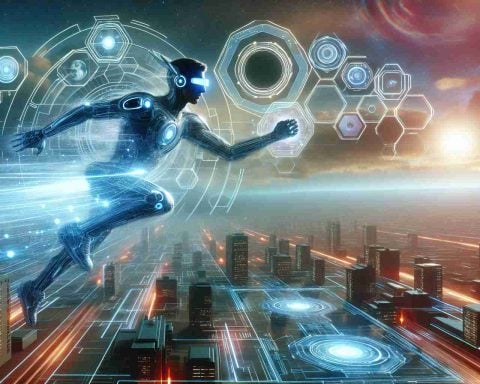- NVIDIA Omniverse aims to unify multiple virtual worlds into a cohesive digital universe.
- The platform supports digital twins, offering potential advancements in various industries such as architecture, manufacturing, media, and entertainment.
- Real-time, photorealistic simulations are enabled through NVIDIA’s GPU and AI expertise, enhancing creativity and interactivity.
- NVIDIA’s collaborations aim to create an integrated digital reality, benefiting fields like scientific research and urban planning.
- The potential of Omniverse could redefine perceptions of digital and physical reality, prompting excitement among tech enthusiasts and industry leaders.
NVIDIA, a leader in graphics processing and AI technologies, is once again setting the stage for a new technological revolution with its latest venture—NVIDIA Omniverse. This novel platform is designed to transform how we envision and interact with the burgeoning digital space known as the metaverse.
Omniverse isn’t just about supercharging virtual reality; it’s about interconnecting diverse virtual worlds into a coherent, accessible digital universe. As the backbone of this technology, NVIDIA seeks to provide an infrastructure that supports the growth and development of digital twins—virtual replicas of physical entities. This innovation could soon revolutionize industries ranging from architecture and manufacturing to media and entertainment.
NVIDIA is leveraging its expertise in GPU technology and AI to enable real-time, photorealistic simulations. With AI-powered asset creation, users can seamlessly generate complex digital environments. This holds promise for creatives and developers, allowing for unprecedented levels of immersion and interactivity.
The implications of NVIDIA Omniverse stretch beyond entertainment. It could facilitate significant advancements in scientific research and urban planning by offering a platform for complex simulations and predictive modeling. Through NVIDIA’s collaboration with major tech firms, the vision of a fully integrated digital reality is moving closer to fruition.
As NVIDIA accelerates towards this ambitious vision, the question remains: will Omniverse be the foundation on which the metaverse flourishes, reshaping how we perceive digital and physical reality? The potential is staggering, leaving tech enthusiasts and industry leaders eager to see where NVIDIA’s trailblazing path will lead.
Unlocking the Future: How NVIDIA’s Omniverse is Shaping Digital Reality
What are the core components and features of NVIDIA Omniverse?
NVIDIA Omniverse stands as a multi-faceted platform designed to transform digital interactions and workflows through several innovative features:
– Interoperability: Omniverse supports seamless connections between different 3D creation and design software, allowing professionals from various fields to collaborate in a unified environment without the hassle of format conversions.
– Real-Time Simulations: Using NVIDIA’s cutting-edge GPU technology, the platform offers real-time photorealistic rendering, enabling users to visualize changes instantly and make data-driven decisions.
– AI-Powered Asset Creation: Advanced AI algorithms aid in generating complex digital assets, reducing effort and time for creatives and developers.
– Scalability and Collaboration: The platform can be scaled across various systems and teams, offering robust support for collaborative efforts, essential for large-scale projects like digital twins and virtual worlds.
For more details, visit NVIDIA.
How is NVIDIA Omniverse impacting various industries?
NVIDIA Omniverse is proving transformative across multiple sectors:
– Architecture and Engineering: By creating highly accurate digital twins, architects and engineers can simulate construction processes, predict structural behavior, and enhance urban planning projects efficiently.
– Media and Entertainment: The platform allows content creators to produce lifelike animations and virtual experiences, enriching storytelling and viewer engagement.
– Manufacturing: Digital twins in manufacturing enhance operational efficiency, predictive maintenance, and supply chain optimization, leading to reduced costs and improved productivity.
– Scientific Research: Omniverse’s simulation capabilities enable researchers to model complex phenomena, contributing to breakthroughs in medicine, environmental science, and beyond.
What challenges and limitations does NVIDIA Omniverse face?
Despite its groundbreaking potential, NVIDIA Omniverse is not without challenges:
– Integration Complexity: Bringing Omniverse into existing workflows may pose technical hurdles, particularly for companies using legacy systems.
– Resource Intensity: Running high-fidelity simulations requires significant computing power, which could be a limitation for smaller enterprises.
– Data Security: As with any platform that handles extensive data and simulation, ensuring data privacy and security remains a top priority.
To explore more on NVIDIA’s initiatives and technologies, visit NVIDIA.
Market Analysis and Future Predictions for NVIDIA Omniverse
The market outlook for NVIDIA Omniverse is robust, with the platform positioned at the intersection of the growing demand for virtual reality, digital twins, and collaborative digital environments. Analysts predict that as more industries recognize the value of digital transformation, Omniverse could lead substantial market growth in digital infrastructure investments. In the coming years, NVIDIA’s continued innovation and strategic partnerships are expected to strengthen its market leadership.
For further insights and detailed market analysis, consider visiting NVIDIA.



















